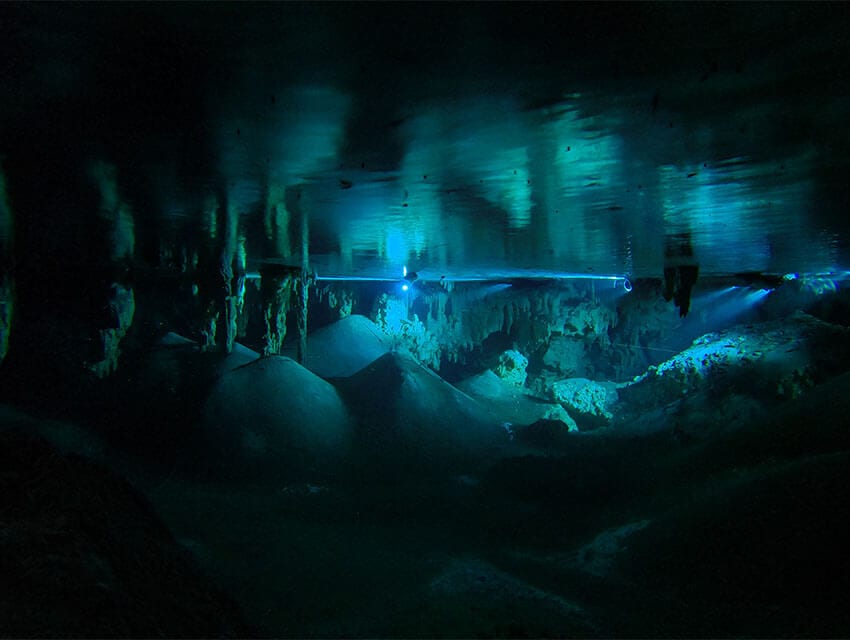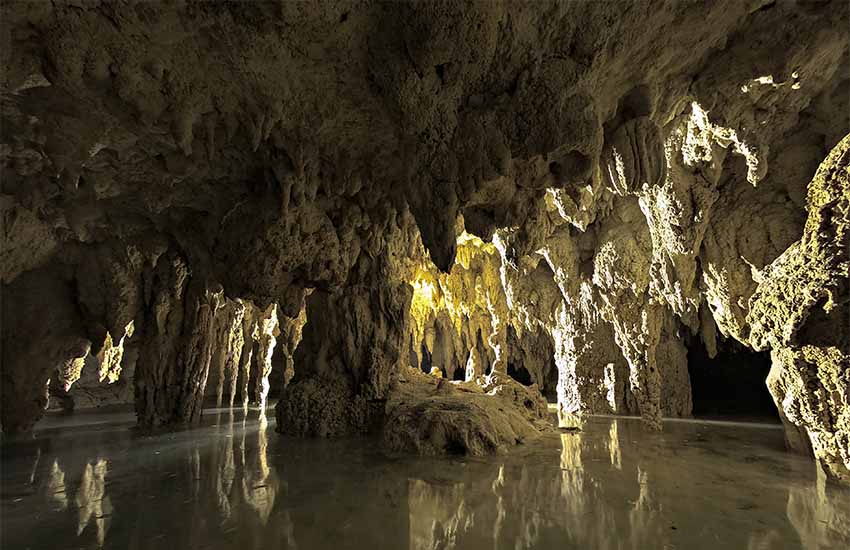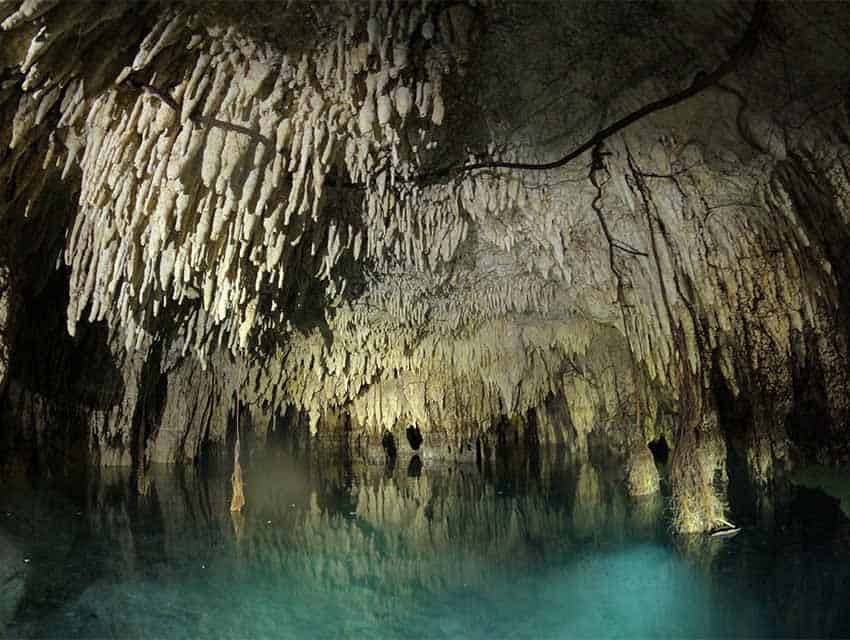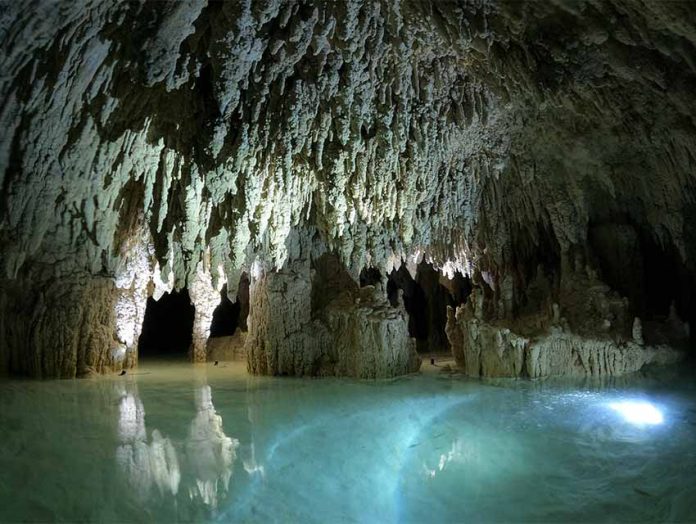The Yucatán Peninsula, a massive limestone platform of 165,000 square kilometers and one of the world’s largest karst formations, hosts one of the planet’s most spectacular subterranean aquifers — thousands of kilometers of underground rivers and lakes.
This hidden aquatic world is largely the result of a rare encounter between cosmic and earthly matter — an enormous meteor that crashed into our planet 65 million years ago.
When the Chicxulub Meteor struck the peninsula, the impact was so great that it fractured the region’s brittle limestone, opening up fissures and holes that allowed virtually all surface water to drain into a subterranean world of dark, sunless caverns and tunnels, creating a subsurface world like no other on Earth.
This system of complex underground rivers and caves finds portals to the dry land above by way of sinkholes, or cenotes. Thirty years ago, scientists documented the existence of about 7,000 cenotes on the peninsula; today, some believe the real number may be twice that.
I recently visited one of these mindboggling cenotes, locally known as the Templo Mayor.

“Welcome to Batman’s world,” Einner Medina proudly tells me as I crouch to avoid hitting my head on limestone formations. I follow him into a cenote in the Chemuyil community in Quintana Roo, on the Yucatán Peninsula.
Medina is the leader of the Bejil-Ha–Water Path — an ecotourist group of young men and women committed to their community, to Mexico and to our planet.
This is my first journey ever into the Mexican (and Maya) underworld, my first close encounter with the cenotes, with what the Maya called that “deep thing — abysm and profundity.” My first contact with these water holes along the long road that all Mexicans must travel through on our journey after death.
There, in the underground, is the doorway to the Mexican underworld. Where the traveling souls of the dead are reflected on the stalactites that hang from the cave’s ceiling and the stalagmites that rise from its floor. In the heart of the Mayan jungle.
Cenotes are our red blood, our mahogany-colored skin, our mouth, eyes and lungs. A place where our ancestral souls rest. And cenotes are all the living things they house: bats; blind white ladies and other blind fishes. They are also the uncolored sponges, bivalves and crustaceans. Cenotes are iguanas, toads, swallows and the Toh, also known as the turquoise-browed motmot.
And cenotes are Xibalbanus tulumensis, a tiny, blind, venomous, hermaphroditic crustacean whose ancestral distribution is linked to the ancient Tethys Sea. With its name, it honors Xibalba, the Maya underworld — a world in which we would be eternally lost if these humid sinkholes did not exist to guide us.
“Let us make the eternal darkness,” Medina says to us. Submerged in water, in the heart of the cenote 12 meters below the forested land, we turn off our small lamps. We make our way through the darkness and the silence.
What my wide-open eyes see is the boundless fusion between eternal darkness and eternal light — a state of grace, of dying without being dead, an indescribable peace, infinite calm. Floating on the water’s surface, I close my eyes, trying to see, but there are no differences when in eternal darkness.
Submerged to the chest, I slowly move my left hand toward the water, feeling it move through the air, independent from the rest of my body, until it enters the water, demonstrating to me that here the boundaries between air and water are just a mirage.
To reach the cenote’s heart, we swim under a dome framed by the speleothems that bear semblance to Tyrannosaurus rex jaws: they are the stalactites that hang from the roof and the stalagmites that grow from the floor — both growing, drop by drop, in opposite directions toward one another over millions of years.
Above, irregular, sharp cones each have a central channel, through which mineralized water runs ever so slowly. Below, there are solid forms, also built drop by drop, rounded like macaroni.
Each stalactite and stalagmite are born from a drop of mineralized water: mirror rocky formations that seek one another, gravitating ever so slowly toward an earthly, geological kiss. They are the yin and yang of the Mexican underworld.

While swimming, I see everywhere thin roots of the poplars descending from the jungle. The cenote is at once a floating and hanging garden.
“Listen to the cenote,” Medina says. I sharpen my hearing but hear nothing.
Suddenly, my face feels the hot air displaced by flapping wings that are not of a bird, and I hear the unmistakable sound of long, membranous bat wings. I smell the sweet and sour breath as it passes.
And then another bat and another, and many more pass, a chiropteran procession. The guardians of the cenote are telling us that we are in their territory. They warn us that they follow our movements and thoughts and that we would be well advised to keep our intentions honorable because we are at their mercy in this eternal darkness.
But, to my surprise, I eventually realize that all of the sounds and smells and movement are an illusion: there are not many bats; it is only the same inquisitive individual circling around us over and over, taking stock of our presence.
Seeing nothing, but with my eyes wide open, I enjoy the sound of its wings and the aromas of the misunderstood and vilified flying creature of the night — and planetary champion at devouring insects, dispersing seeds and pollinating plants. Blessed are the bats, the only winged mammal that has conquered the entire planet except for Antarctica.
Medina interrupts my thoughts. “That is nothing, Omar. Come back soon to listen to the sound of bells when many bats are flying and their wings brush against the stalactites.”
I can’t imagine anything more glorious than a bat symphony performed in the Mexican underworld.
Seconds after we turn our lamps back on, I see air bubbles emerging on the cenote’s surface. What I see takes me back to memories of Stanley Kubrick’s film 2001: A Space Odyssey and my favorite James Bond movie, Thunderball.
Just 10 meters from us, two slender divers, like lost subterranean angels in silvery wetsuits, are being pulled through the water by small propulsion vehicles equipped with powerful lamps.
At first, I thought I was hallucinating due to insufficient oxygen levels in the cave; then I thought that the divers were aliens from another galaxy. Finally, I thought I had died and begun my own path to Xibalba.
Seeing my astonishment, Medina calmed me down and explained that they were a couple of the many speleologists who spend their life studying and protecting the cenotes and underground rivers.

The time comes to bid farewell to the underworld’s doorway. From the entrance to the inundated cave, I look one last time at the ray of sunlight entering through a crack on the cenote’s other side, a shaft of radiance where the sky meets the underworld.
Through my dive mask, I lift my head from the water’s surface for a final glimpse at the sun’s illumination on a small rock platform — a natural shelf that likely served as a contemplative place for a Maya emperor or a priest, a shining spot visible only to those convinced that the boundaries between air and water are but an illusion.
- I thank Einner Medina for his patience in teaching us how to make our way through the eternal darkness and listen to the cenote. All photographs and videos used in this essay belong to his group. Visit their website, where you can learn how to listen to the cenote yourself.
Omar Vidal, a scientist, was a university professor in Mexico, is a former senior officer at the UN Environment Program and the former director-general of the World Wildlife Fund-Mexico.
